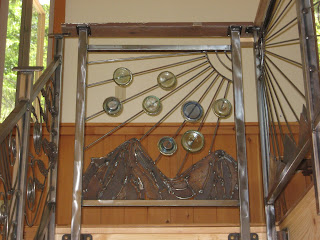I love fabrics – their colors,
textures, and patterns, the way they cling or wrap, the way they fold, sway, or
layer. It’s hard to resist buying a beautiful fabric, even if I don’t know what
to do with it. Consequently, I have always had shelves and drawers of fabrics
available for the day I wake up with a hankering to sew. Then I drag them all
out and spread them on the floor or the couch, laying a pattern for a skirt with one, a
different pattern over another, matching fabrics and patterns, and, usually,
choosing both for the next project.
Sometimes, I put everything away without
having decided a thing. I could spend hours pulling out my fabrics, fluffing
them out, matching fabrics and relishing their colors and textures and happily
enveloping myself in my beautiful fabrics.
In my old house it was tedious
having to put my sewing away at the end of the day because I had to make dinner
in the same room or because guests were coming or because I was out of time
that day for that project. So, in designing my new house, I asked for a sewing
room, a room where, when it was time for dinner, I could leave everything piled
on the floor, where if visitors came, I could just close the door on the mess. The
sewing machine could stay out. I could set up the ironing board in that room
and leave it up. I wanted a room where I could sew and stop sewing and then
start again.
And that’s what I got. The sewing
room is across the main room from the writing nook. In addition to the two
chests of drawers and two trunks that hold fabrics, it contains baskets and
bags of yarns for knitting projects. My tapestry loom is on one wall, cards for
card weaving in a bag under it, crafts books and sewing patterns in the book case with the sewing box my father made on the top shelf.
The sewing
machine sits on a favorite oak desk under the south-facing window. On the wall
are paintings by friends and family members and an embroidery I did for my
mother years ago. Dresses yet to be mended hang on a rack; the
not-quite-finished quilt stays next to the sewing machine.
One of the rules I discovered for
one-room-cabin living in my old house was that everything had to serve a dual
purpose or more. That principle holds for my sewing room now, as it doubles as
a guest room. Imagine! The luxury of giving my guests a room of their own. The
futon couch folds down for a bed, and guests can close the door for their
privacy.
The best thing about the sewing
room, though, is not that it keeps my sewing projects contained or that it can
sleep two guests but that it has a secret tunnel. A short door on one wall
opens into a cabinet where I store blankets and cushions. The same cabinet is
accessible from the other side, through a door under the stairs. When my
granddaughter comes to visit, I take out all the blankets and cushions, leaving
the tunnel empty. As soon as she gets here, she goes straight to the tunnel
door. She crawls in and closes the door behind her. “Where am I, Amma-Dee? Try
to find me!” The tunnel in the sewing room is my granddaughter’s favorite room
in the house.























